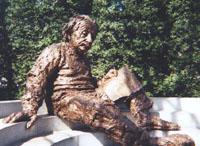 lbert Einstein postulated the existence of BECs in 1924
lbert Einstein postulated the existence of BECs in 1924Some clusters of very cold atoms have physicists foxed, the American Physical Society's March meeting heard this week in Seattle. Bose-Einstein condensates, the bizarre form of matter that bridges the tiny, topsy-turvy world of quantum mechanics and the everyday world, are pulling dramatic tricks with which today's theories just can't cope.
Ordinary matter comes in five forms. Three -- solids, liquids and gases -- are familiar. The fourth, plasmas, are found in high-temperature systems such as flames and fluorescent tubes. You could be forgiven for having never heard of the fifth: the Bose-Einstein condensate (BEC).
Christened in honour of Albert Einstein, who postulated their existence in 1924 based on the work of Satyendra Bose, the first BECs were produced by Eric Cornell and Carl Wieman at the University of Colorado in 1995.
These curious entities never occur naturally, can exist only at temperatures a few ten-billionths of a degree above absolute zero (-273 degrees Celsius) and until recently could contain only a few hundred atoms. Even so, they fascinate physicists keen to deepen their understanding of quantum phenomena.
As an atom cools, it moves increasingly slowly, causing its wavefunction (roughly speaking, the area in which it might be found) to grow. Eventually, the wavefunctions from neighbouring atoms overlap and the whole condensate starts to behave as a single quantum-mechanical object.
It is hard to form a stable BEC of more than 100 atoms, and seeing what's going on in condensates so small is very difficult. The recent discovery of a particular mode in rubidium-85 called a 'Feshbach resonance' increased the maximum condensate size to several tens of thousands of atoms -- but only at just two billionths of a degree above absolute zero. "Damn cold by anyone's standards," as Wieman says.
Nonetheless, the new technique gave researchers a tool rather like a pair of magnetic pliers to manipulate the condensates. Their results have them scratching their heads.
When compressed quickly enough, a condensate explodes, blasting off the outer atoms and leaving a cold, collapsed remnant. The effect has been dubbed a 'bosenova' because of its similarity to a supernova (an exploding star).
Unsurprisingly, the size of the remnant left when the condensate does a bosenova depends on the energy of the explosion. But, strangely, the number of atoms blasted off does not change. This is a real surprise, particularly as researchers currently have no idea what happens to the remaining atoms.
Unexplained jets have also been observed projecting from the mass of atoms just before it collapses. And the more egg-shaped the initial condensate (physicists call this anisotropic), the rounder the remnant -- entirely contrary to expectations. Charles W. Clark of the National Institute of Standards and Technology in Boulder, Colorado, has even observed curious smoke-ring formations within a BEC1.
"These are not complicated crystals with many degrees of freedom and complex interactions we are talking about; they are just atoms. We understand atoms, right?" Wieman jokes. "Basic physics is missing to explain these effects."
